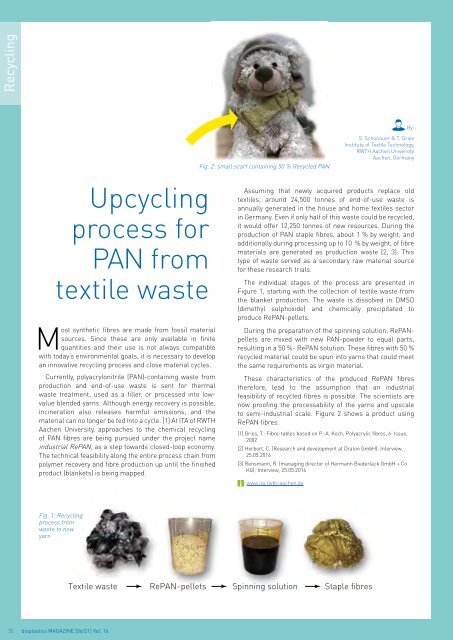Issue 06/2021
Highlights: Coating Films, Flexibles, Bags Basics: Cellulose based bioplastics
Highlights:
Coating
Films, Flexibles, Bags
Basics: Cellulose based bioplastics
Create successful ePaper yourself
Turn your PDF publications into a flip-book with our unique Google optimized e-Paper software.
Recycling<br />
By:<br />
Fig. 2: small scarf containing 50 % Recycled PAN<br />
S. Schonauer & T. Gries<br />
Institute of Textile Technology,<br />
RWTH Aachen University<br />
Aachen, Germany<br />
Upcycling<br />
process for<br />
PAN from<br />
textile waste<br />
Most synthetic fibres are made from fossil material<br />
sources. Since these are only available in finite<br />
quantities and their use is not always compatible<br />
with today’s environmental goals, it is necessary to develop<br />
an innovative recycling process and close material cycles.<br />
Currently, polyacrylonitrile (PAN)-containing waste from<br />
production and end-of-use waste is sent for thermal<br />
waste treatment, used as a filler, or processed into lowvalue<br />
blended yarns. Although energy recovery is possible,<br />
incineration also releases harmful emissions, and the<br />
material can no longer be fed into a cycle. [1] At ITA of RWTH<br />
Aachen University, approaches to the chemical recycling<br />
of PAN fibres are being pursued under the project name<br />
industrial RePAN, as a step towards closed-loop economy.<br />
The technical feasibility along the entire process chain from<br />
polymer recovery and fibre production up until the finished<br />
product (blankets) is being mapped.<br />
Assuming that newly acquired products replace old<br />
textiles, around 24,500 tonnes of end-of-use waste is<br />
annually generated in the house and home textiles sector<br />
in Germany. Even if only half of this waste could be recycled,<br />
it would offer 12,250 tonnes of new resources. During the<br />
production of PAN staple fibres, about 1 % by weight, and<br />
additionally during processing up to 10 % by weight, of fibre<br />
materials are generated as production waste [2, 3]. This<br />
type of waste served as a secondary raw material source<br />
for these research trials.<br />
The individual stages of the process are presented in<br />
Figure 1, starting with the collection of textile waste from<br />
the blanket production. The waste is dissolved in DMSO<br />
(dimethyl sulphoxide) and chemically precipitated to<br />
produce RePAN-pellets.<br />
During the preparation of the spinning solution, RePANpellets<br />
are mixed with new PAN-powder to equal parts,<br />
resulting in a 50 %- RePAN solution. These fibres with 50 %<br />
recycled material could be spun into yarns that could meet<br />
the same requirements as virgin material.<br />
These characteristics of the produced RePAN fibres<br />
therefore, lead to the assumption that an industrial<br />
feasibility of recycled fibres is possible. The scientists are<br />
now proofing the processability of the yarns and upscale<br />
to semi-industrial scale. Figure 2 shows a product using<br />
RePAN fibres.<br />
[1] Gries, T.: Fibre-tables based on P.-A. Koch, Polyacrylic fibres, 6. <strong>Issue</strong>,<br />
2002<br />
[2] Herbert, C. (Research and development at Dralon GmbH): Interview,<br />
25.05.2016<br />
[3] Rensmann, R. (managing director of Hermann Biederlack GmbH + Co<br />
KG): Interview, 25.05.2016<br />
www.ita.rwth-aachen.de<br />
Fig. 1: Recycling<br />
process from<br />
waste to new<br />
yarn<br />
Textile waste<br />
RePAN-pellets<br />
Spinning solution<br />
Staple fibres<br />
32 bioplastics MAGAZINE [<strong>06</strong>/21] Vol. 16

















